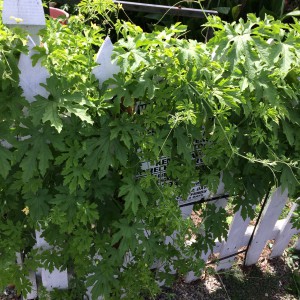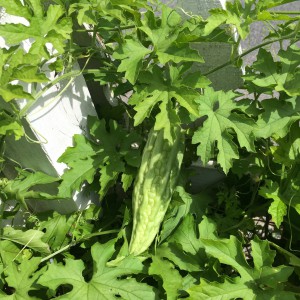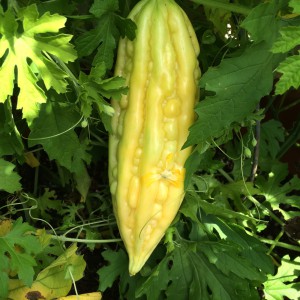A Bitter Melon vine along a fence.
A ripening Bitter Melon fruit.
A nearly ripe Bitter Melon.
Bitter Melon
Momordica charantia
The fruit of the bitter melon, with all its warts and ridges, looks like the mutant cross between a cucumber and an alligator. This member of the squash family, Cucurbitaceae, goes by a number of different names such as bitter gourd, balsam pear, African cucumber, goya and karela. The strange looking fruit of this herbaceous annual vine has been a staple food for thousands of years in Asia, India and Africa. Now, it is beginning to be seen more and more in western gardens. Bitter melon is thought to be indigenous to southern China and eastern India where it was first domesticated.
It is a rampant growing vine with 5- or 6-lobed leaves and vanilla-scented yellow flowers that when pollinated form very bitter warty, oblong fruit. Bitter melon vines can grow up to 13- to 16-feet long if properly supported.
The young fruit are prized in Asian and Indian cooking despite their bitter flavor. The immature melons are picked at 4 to 6 inches and used in many different recipes. They can be stuffed with shrimp or pork and steamed, sliced in soups and stir-fries, or pickled to name a few. Because of their unusual bitter flavor, it is best to pair them with other strong flavored foods such as Chinese black beans, chili peppers, garlic, or coconut milk to counteract the bitter taste.
In order to reduce the bitterness of the fruit, some home cooks peel them with a carrot peeler or scrape the warty skin off with a knife, then make a length-wise cut in the fruit to remove the seeds and pulp. Sea salt is then rubbed inside and outside. Let the fruit weep for 2 hours then squeeze out the juice, this will decrease most of the bitterness. An alternative method is to par-boil them, but this changes their consistency. The flesh should be a watery, crunchy texture much like cucumbers or peppers.
Bitter melons are a good source of beta-carotene, iron, potassium, calcium, phosphorous, vitamins C, B1, B2, and B3. With their antiviral and antibacterial properties, they are used in many medicinal preparations such as juices, teas, extracts, and bathes. The fruit is consumed to treat malaria since they contain quinine. Historically, they are used to treat type 2 diabetes since they enable the uptake of glucose and are even recommended by the National Diabetes Association. The roots are sometimes used to heal hemorrhoids. The leaves are used in poultices for skin irritations like acne, burns, scabies, ringworm, and measles. Bitter melon has been proven by western scientists to inhibit tumor growth and HIV-1 infections. They are also thought to be a remedy for rheumatism, gout, and gastrointestinal problems.
These plants prefer a well-drained soil with a pH of 5.5 to 6.7. Like most melons, they need even soil moisture in a sunny location or planted in light shade with the vines extending out into full sun. Bitter melons thrive when given at least 6 hours of sun in a hot and humid climate.
Plant the vines at least 4 feet apart so they will have space to grow. Give the young plants plenty support by planting them along a fence or next to an arbor or trellis. Trellising reduces disease problems by increasing air circulation and makes the fruit easier to harvest. Bitter melon vines are prone to rot if in contact with the moist ground, so mulch beneath them with 2 to 3 inches of wheat straw. Use a slow release fertilizer such as 14-14-14 at the time of planting or a mixture of bone meal and composted manure. About midway through the growing season, fertilize with a liquid fertilizer and then again at about 60 days after planting. This fertilization program along with lots of water will keep the vines growing vigorously.
In warmer areas, you can direct sow bitter melon seeds into hills 3-4 feet apart after the soil temperature has reached 64-degrees F. Plant 8 to 10 seeds per hill and cover them with 1 inch of soil. Keep well-watered. Then once the seeds are germinated with 2 to 3 leaves, thin each hill to 4 plants each.
For better germination in cooler climates, pre-sprout seed by soaking in water for 24 hours. Then wrap the seed in a warm, damp paper towel, put them in a plastic bag and keep at 80- to 84-degrees F. Once partially germinated, plant them in deep plug trays or 4 inch pots. Plant-out the young plants in a prepared bed of well-drained soil once they are rooted to the bottom of the plugs or pots.
An alternative method of propagation is by rooted cuttings. Take 10- to 12-inch cuttings from an established vine. Place the cuttings in water for 10 to 15 days until rooted. Then plant in pots as an intermediary step before planting them in the field.
Pollination can be accomplished by hand if there are not enough honeybees or other pollinators in your area. Since bitter melon vines bare both male and female flowers, take a male flower, rollback the petals and dab pollen on each of the female flower’s stigma. The female flowers can be identified by a swelling like a tiny melon behind the bloom. Commercial growers bring in hives of honeybees each spring to pollinate their crop of bitter melons.
The first fruit usually appear about 2 months after sowing. Pick the fruit when they are 4- to 6-inches long, otherwise the older fruit tend to be fibrous and more intensely flavored. To encourage new fruit growth and prevent over-ripening, try to pick fruit every 2 to 3 days. After harvesting, the fruit will keep in a cool dark place for 3 to 4 days. Stored in a paper or plastic bag in the refrigerator crisper drawer they will last up to 4 weeks. The fruit can also be sliced and dried in a food dehydrator then used for months.
Although bitter melons are relatively hardy, they can be plagued by many of the same maladies as other members of the Cucurbit family. They are susceptible to various rots and fungal diseases such as powdery mildew and downy mildew. These vines are also prone to watermelon mosaic virus. Insects such as fruit flies, spotted cucumber beetles, striped cucumber beetles, and spider mites can be a problem too. Ask your county extension agent or local garden center expert for cultural practices or contact sprays to solve any problems you might encounter.
Traditional varieties of bitter melon are named after their physical attributes like ‘Indian Long Green’, ‘Green Skin’ and ‘Large Top’. Some of the new hybrids such as ‘Indian Long White’ are better suited to growing in more temperate climates. While other new hybrids, such as ‘Mara Long’, are improvements on older varieties.
References & External Links:
- Oriental Vegetables- The Complete Guide for the Gardening Cook, J. Larkcom, Kodasha, 2008
- Vegetables,Herbs & Fruits – An Illustrated Encyclopedia, M. Biggs, J. McVicar & B. Flowerdew, Firefly Book, 2013
- “Growing Bitter Melons – Bonnie Plants.” Bonnie Plants. <http://www.bonnieplants.com/growing/growing -bitter- melon/>.
- “Better Living through Bitter Melon.” <http://www.bittermelon.org/cultivation.html/>.



